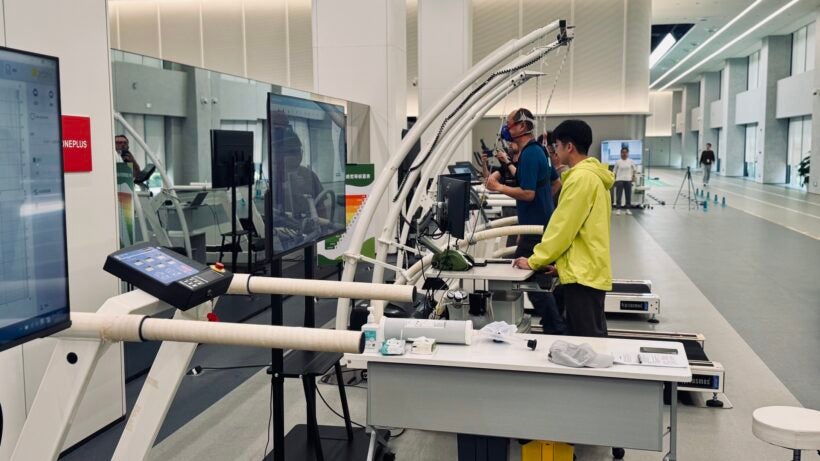Everything you need to know about the fitness estimation on your wearable.
Almost every major smartwatch or sports watch will now estimate your VO2 max without you having to take a gruelling lab test.
It’s often branded differently from ‘VO2 max’ on your device or companion app, but it’s now prevalent across the industry. Apple, Garmin, Whoop, and Oura are just some of the companies using bespoke algorithms to detect your fitness level.
It means what was once a metric for elite athletes has become a piece of fitness data that recreational runners and gym lovers can start to obsess over and pay attention to.
But… what exactly is VO2 max—and, most importantly, can you trust a fitness tracker or smartwatch to give you an accurate reading? This guide delves into the murky world of VO2 max to help answer those questions and more.
What is VO2 max?

VO2 max refers to your body’s ability to use oxygen during exercise. It’s typically measured in milliliters consumed per minute per kilogram of body weight (mL/kg/min).
The amount of oxygen you transfer to your blood changes and increases as you start exercising; VO2 max is the level at which the amount of oxygen being processed maxes out and plateaus.
As you train, your body learns to process more oxygen, which improves your aerobic fitness and performance. So, VO2 max is the best measure of your fitness and a great way to track your improvement in performance.
Why is VO2 max such a good metric?
We’ve written thousands of words here at Wareable about heart rate, and how it’s a constant figure that can provide a baseline for your training.
While that’s true, it’s only a constant measure of effort—e.g., how hard you’re working. In reality, it can be hugely affected by heat, terrain, and fatigue, among other factors.
VO2 max isn’t affected by outside factors. Instead, it’s a measure of your potential. While it does a different job than training by heart rate, it’s an unbeatable tool for gauging your fitness.
Which devices track VO2 max?

There are plenty of wearables to choose from if you want to get up close and personal with your VO2 max. Here’s just a small selection of the brands that offer it right now:
- Apple
- Coros
- Garmin
- Google/Fitbit
- Huawei
- Whoop
- Oura
- OnePlus
- Samsung
- Polar
Why is tracking VO2 max essential for fitness fans?

So, what are the benefits of knowing your VO2 max? Garmin offers a good explanation in its support page of the ‘VO2 Max Estimates‘ that some Garmin watches can deliver.
VO2 max offers a better understanding of your fitness level. It looks at the maximum rate at which you can bring oxygen into the body and transport it to muscles to fuel your aerobic energy production.
A low VO2 max score can indicate poor fitness levels, while a higher score can suggest a greater capacity to perform during exercise.
Your VO2 max will adjust depending on your lifestyle and training habits. This allows you to track your improvement and understand your potential if you get back into shape.
Garmin has sought to make it more insightful for those who aren’t runners, with specific VO2 max estimation available for trail running and cycling on newer watches.
You can compare the VO2 max figures to those of others to see how they compare. This can help you better understand the level of fitness you need to reach to be competitive in a competition or to keep up with other fitness-loving friends.
How is VO2 max calculated on wearables?

A proper VO2 max test in a lab requires wearing a mask while completing an increasingly strenuous treadmill run. The volume of oxygen entering and leaving your lungs is measured, and blood oxygen is tested using blood samples taken from the finger.
A wristband or watch cannot provide the same level of detail, so measurements will always be estimates based on each brand’s in-house algorithms. This is also why there are often significant discrepancies between scores on different wearables. Everybody measures it differently.
One key variable you can control is inputting your age, sex, and weight into the device correctly, as this data underpins many of the assumptions your device will make about you. The next crucial element is pace/speed, which is almost always measured accurately enough from modern smartwatches and sports watches.
However, heart rate data also makes up a significant portion of the equation, and this is harder for wearables to assess accurately. We recommend an HRM chest strap for maximum accuracy when working out (particularly at the higher heart rate ranges required for a VO2 max test). Still, devices from reputable brands such as Apple, Google, and Garmin are all accurate enough from the wrist.
In a white paper on its methods, which are fairly typical for wearable devices, Firstbeat (part of Garmin) describes its process of gathering VO2 max data:
- The personal background info (at least age) is logged.
- The person starts to exercise with a device that measures heart rate and speed.
- The collected data is segmented to different heart rate ranges and the reliability of different data segments is calculated.
- The most reliable data segments are used to estimate a person’s aerobic fitness level (VO2max) by utilising either linear or nonlinear dependency between the person’s heart rate and speed data.
How to change your VO2 max score

Working on your aerobic activity is still the best way to affect your VO2 max score, and Firstbeat says that you should see a physiological change in 4-12 weeks.
“A beginner may increase his/her fitness level during 4-10 weeks of successive training by up to 10-20%,” its white paper says.
But it’s also key to ensure that your exercise intensity matches your VO2 max. If you’re not training hard enough, your levels could decrease.
How accurate are VO2 max estimates?
Wearable tech is based on many estimations, and we often compromise on accuracy for convenience. That’s certainly the case here, where a proper VO2 max test is expensive, gruelling, and uncomfortable.
There isn’t data for all VO2 max devices, but in its white paper, Firstbeat claimed a 95% accuracy based on 2,690 runs from 79 individuals. Given the simplicity of acquiring the data, we judge that to be a pretty decent compromise.
“In a vast majority of the measurements, the error was below 3.5 ml/kg/min and the error was evenly distributed around the mean value. For perspective, the error in a typical indirect sub-maximal test is 10-15% and in a direct laboratory test about 5%,” the report said.
With the rise of optical (light-based) heart rate monitors offering VO2 max testing, there is a big question over accuracy. Companies still use chest straps to generate those VO2 max assessments, as it remains the gold standard. Ultimately, if you’re not generating high precision, it will be hard to truly benefit from it.
Things are getting better on the optical heart rate monitoring front. However, there’s a reason why many companies that offer VO2 scores still recommend using a chest strap for getting accurate training and fitness insights.
Can your VO2 max score be wrong?
You do have to be careful about VO2 max. When running uphill, your heart rate is typically higher and your speed is slower, which could be evaluated as a lower fitness level. The opposite can be true for downhill runs. But all should be well if your runs and training schedule have a good mix of routes.
Those who exclusively run trails can find VO2 max estimates to be too low, thanks to the inherently slower nature of running away from the asphalt. That’s why Garmin introduced a trail-specific VO2 max score on its outdoor watches.
Ultimately, make sure you get out plenty of times and track sessions and workouts before you start obsessing over your scores.




